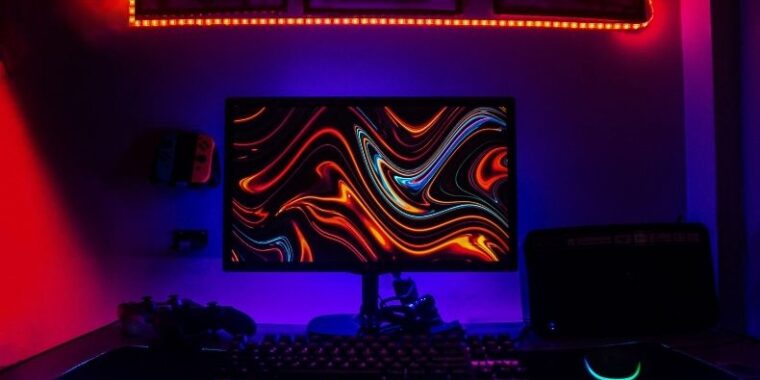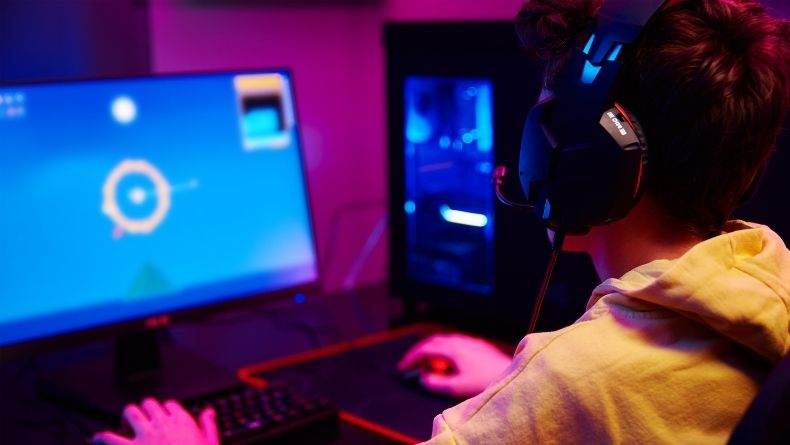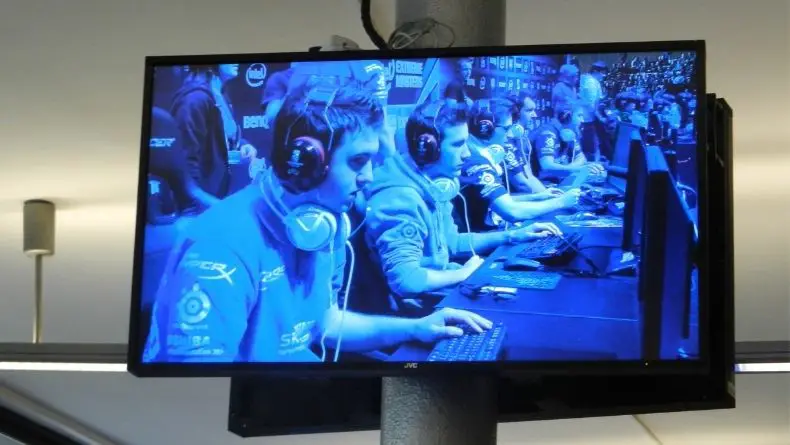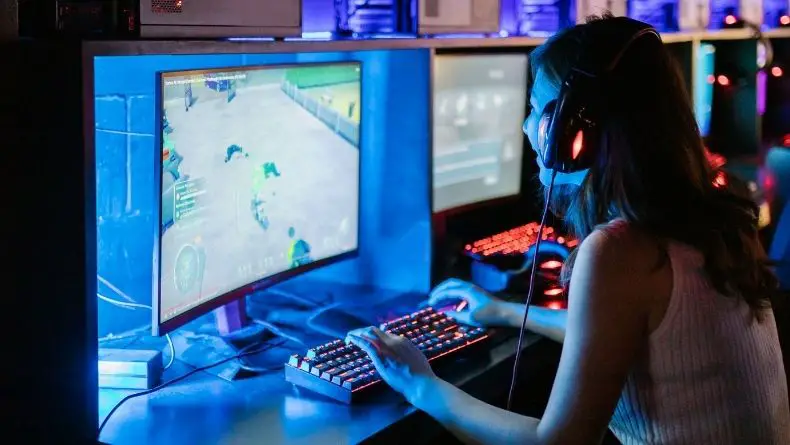
Globally, the number of gamers is rising. This implies that first-time gamers are seeking a good gaming monitor. Their gaming pals recommend a 60 Hz monitor as a good start. However, when they think of purchasing it, the age-old issue still haunts: Is a 60 Hz monitor good for gaming today?
If you’re just getting started, this 60 Hz monitor is an excellent choice. It’s excellent since it’s a low-cost gaming monitor appropriate for single-player and casual strategic games. The display is clean and speedy, so you won’t have to worry about refresh rates while gaming.
A 60 Hz display has a wide range of benefits and drawbacks, which we’ll explore here in more depth. By reading this article, you will have a thorough understanding of your gaming experience on a 60 Hz monitor. Let’s jump right to it.
- Refresh Rate Simplified
- The Best Refresh Rate for 60 Hz Monitors
- Why is a Higher Refresh Rate Better for Competitive Gaming?
- What Response Time is Sufficient for a Gaming Monitor?
- Is a 60 Hz Monitor Good for Gaming?
- Which Type of Games Are Good to Play on a 60 Hz Monitor?
- Why Shouldn’t You Underestimate a 60 Hz Monitor?
- What Type of Gamer Should Get a 60 Hz Monitor?
- Affordability of 60 Hz Monitors
- What Are the Advantages and Disadvantages of a 60 Hz Monitor?
- Differences between a Gaming Monitor and a Normal Monitor
- Frequently Asked Questions
- Bottom Line
Refresh Rate Simplified

Refresh rate is a statistic that measures how long it takes for your website to update. The higher the refresh rate, the quicker the display and the smoother your gaming experience.
As a consequence of a higher refresh rate, you will have a smooth experience with realistic and fast gaming.
There are several refresh rate monitors available, such as 60 Hz, 120 Hz, 96 Hz, 96 Hz, etc. A 60 Hz display can refresh 60 times per second, which is sufficient for recreational gaming.
You might reap several benefits when you utilize a higher refresh rate monitor. When playing multiplayer games, you may notice that adversaries move quicker than a player with a 60 Hz display, even if it is just by a few milliseconds, which can be crucial for good gameplay.
The Best Refresh Rate for 60 Hz Monitors

A high refresh rate is vital for competitive gamers to maintain a competitive advantage over rivals. Earlier, we talked about how a high refresh rate monitor affects your gameplay though newbies won’t be able to detect the difference.
So, 144Hz is the ideal refresh rate that is suitable for all gaming monitors to experience tear-free gaming with less input lag. However, an extremely competitive gamer may need a monitor with higher refresh rates.
If you are merely interested in single-player gaming, then you might want to opt for a 60 Hz monitor. The casual and occasional gamers don’t need to spend a lot to have a slightly improved refreshable monitor. Instead, it would be better for you to spend your money on a whole new gaming console or PC setup.
Your computer’s FPS (frames per second) must also be compatible with the refresh rate. If a game can be seen at 60Hz, the computer must be capable of running 60 FPS.
If you exceed more frames per second than 60, you cannot see frames below the maximum refresh rate because it has reached the refresh rate limits.
Why is a Higher Refresh Rate Better for Competitive Gaming?
If you go even higher, you will experience smoother gameplay, but you also have to spend more money. We think only avid gamers may notice the improved higher refresh rate on their monitor displays.
This high refresh rate monitor is required in highly competitive games, like Fortnite, Mortal Kombat, Call of Duty, Rocket League, etc.
However, higher refresh rate monitors come with their drawbacks besides their perks. They are a bit more expensive than a 60 Hz monitor. So, when choosing, consider the affordability because, for non-avid gamers, a 60 Hz monitor is more than enough for gaming. It’s not worth spending more on a monitor in that case.
What Response Time is Sufficient for a Gaming Monitor?

You would probably know one thing if you have a minimal idea about gaming monitors or any monitor. That is, the less response time it takes, the more satisfactory result you will experience with your monitor.
In the short term, response times mean the time it takes for a monitor to change from one color to another.
If your monitor takes a lot of time to change the color of your gaming monitor, the colors will blend, resulting in less sharpness and less smooth gameplay.
Besides, fast-paced games need minimum response times to provide you with an edge over your competitors.
If you want to have the best images and color shows while playing the game, the recommended response time will be between 1-5 milliseconds. This is the ideal response time to experience smoother gameplay of high-resolution games on a 60 Hz monitor.
When you use monitors with 5 millisecond response times, it’s sufficient for casual and single-player gaming. When it comes to highly competitive games, you would appreciate a response time of 1 ms.
However, lower response time is a bit of an expensive feature, like a higher refresh rate and lower input lag.
Is a 60 Hz Monitor Good for Gaming?

For a short answer, gaming with 60 Hz monitors is more or less enough for most gamers. When you are more interested in single-player and casual gaming, you don’t need a better monitor. Luckily for you, a 60 Hz monitor comes at an affordable price.
Besides, there is no tangible benefit you will immediately notice in other monitors. Higher refresh rate monitors have a little edge over 60 Hz monitors; thus, those edges will be helpful in a competitive environment where every second counts.
Additionally, every feature you want to have on your monitor to begin gaming is present on this monitor. There is no huge difference, and it is barely noticeable for non-gamers.
However, when you are an avid gamer and want to maintain a competitive edge over your gaming buddies, you should probably opt for a higher refresh rate monitor and higher FPS.
You can play most games smoothly on your 60 Hz monitor, but fast-paced games like Counter-Strike need at least a 144 Hz monitor. Don’t worry; in a few years, when you grow as a gamer, you can always upgrade your PC.
The vast majority of competitive gamers start their journey with these mid-range 60 Hz monitors. They will gradually move to a faster monitor as their needs change.
Which Type of Games Are Good to Play on a 60 Hz Monitor?

Racing games, run games, strategy, simulations, etc., are perfectly fine to play on 60 Hz monitors. This is the right gaming monitor for this genre of games.
You won’t have issues like motion blur or problems with the frame rate in this type of game. Moreover, you can add more features that suit you as a more competitive game day-by-day. If you own this budget-friendly monitor, you should be able to play at 60 FPS at full HD 1080p with only minor graphics adjustments on screen.
Why Shouldn’t You Underestimate a 60 Hz Monitor?

A 60 Hz monitor is an excellent option for people who are not so into competitive games. You wouldn’t have problems like screen tearing when playing classic PC games.
It’s recommended to invest your money in a 60 Hz display with IPS technology. IPS is a kind of LCD panel that delivers more outstanding color quality and viewing angles than a TN monitor panel.
Lastly, we want to say you shouldn’t underestimate a 60 Hz monitor. It can provide you with a great experience with screen refreshes on a gaming PC. With a power supply and gaming setup on your PC, the magic will mesmerize you.
What Type of Gamer Should Get a 60 Hz Monitor?

The short answer is that a non-gamer or newbie gamer can utilize a 60 Hz monitor with great satisfaction. When you use your PC on a regular basis, you add a gaming setup to your display.
Consequently, you will experience smooth play on-screen on your PC display. Just about everyone worldwide now has access to a computer, and you want your computer to be compatible with a wide range of games.
Even if you do not intend to play games like true professional gamers, I’m sure you would love to update your current computer. In that case, a 60 Hz monitor should be sufficient.
Apart from that, your original computer will not need to be replaced. Enjoying that pleasure will be enhanced by a high frame rate and refresh rate. You will not, however, experience the same refresh rates as you would with a 144 Hz display.
When playing casual games, you won’t be able to see the difference between a bright screen and a high-end performance.
Affordability of 60 Hz Monitors

It would be best if you did not spend extra on slight improvements in your gameplay. It’s also possible that you won’t notice the difference that a higher refresh rate screen offers.
I recommend that you purchase a 60 Hz gaming monitor if you are a novice. Generally, higher refresh rate displays cost more money to purchase. (My personal picks would be Acer K242HQL or SAMSUNG LC24F390FHNXZA)
In addition, you would require complementary hardware as well as system administration to run your high refresh rate monitor, and you may lose more money as a result.
Usually, gaming monitors are a bit expensive for their higher refresh rates and lower input lags. 60 Hz monitors are somewhat affordable in comparison to others. They also come with everything you initially need. You can experience decently realistic gameplay on that.
Besides, if you intend to be a pro and competitive gamer, you will change your monitor in the future. Therefore, this 60 Hz monitor is more than enough for a newbie gamer.
What Are the Advantages and Disadvantages of a 60 Hz Monitor?

A 60 Hz monitor has its own set of pros and cons, just like any other kind of monitor. It would be preferable if you take all of these factors into consideration before making your decision.
Before choosing a monitor, you should have a thorough understanding of what you’re getting into. In this section, we will discuss the advantages and disadvantages of using a 60Hz monitor.
Advantages
Full Resolution
60 Hz monitors will give you full HD resolution along with 1080p, 1440p, and 4k refresh rates of 60 Hz. For this full resolution, you can even watch a Bluray movie with a 1080p on a 60 Hz monitor.
Not to mention, progressive frames can be displayed at 1920 to 1080 resolution per second of any video without an issue. This monitor can even run on a 4k screen if you have a 60 FPS set on it.
Significant Performance Gain
The custom-built nature of the G-Sync monitor, for example, allows for even more significant performance gains.
For the performance gain, framerates can exceed 100 FPS while gaming. As a result, gamers can enjoy enhanced responsiveness during gameplay.
Affordability
As for the question of affordability, a 60 Hz monitor is a great choice you can make without a second thought. Compared to most monitors, you’ll hardly find a high-functioning monitor at such an affordable price.
With ultra graphics and 1080p resolution, this monitor can run any game with smooth functioning. Hence, if your budget is tight, but you’re looking for good specs, you should opt for this monitor.
Change Refresh Rates and Response Time
You can also change its refresh rate and response time as per your requirements. An average monitor can hold a response time of 5 minutes. However, some gamers like their response rate to be set to 1-2 minutes.
You can change the response time on a 60 Hz monitor. This allows users to customize the response time according to their needs. Moreover, the refresh rates can be changed anytime per your requirements.
Eye Comfort
In terms of eye comfort, a 60 Hz monitor causes significantly less damage to your eyes compared to other regular monitors. You will not notice a substantial difference since our eyes are not well adapted to faster frames than 60 frames per second.
Disadvantages

Lower Refresh Rates
The most significant disadvantage of these displays is their lower refresh rates, which are measured at 60 Hz on the frame rate counter. Even though the refresh rates can be changed, it might not be enough for some high graphic games.
Sloppy Performance
When playing fast-paced games, serious gamers may readily detect some sluggishness on the screen. As some games require faster run times, you might face a lower run time, which might result in a sloppy performance.
Less Amount of Time to Change
If you play multiplayer games that require the least amount of time to change colors between games, this is not the best option for you. When using multiple monitors side-by-side, you might experience this situation.
Blur Resolution
You might see blur resolution in the game. This scenario happens when multiple types of software are running in the background simultaneously. As some gamers require multiple software to run in the background while playing the game, the resolution might get blurred from time to time.
Unsuitable for Pro Gaming
You may experience poor gaming experiences along the way if you seek to be a pro gamer due to lower refresh rates with 60 Hz in the FPS counter.
Low Mouse Sensitivity
60 Hz refresh rates may cause a problem in a better game because of high mouse sensitivity. For intense gaming, some gamers might prefer higher mouse sensitivity. At times like this, you might be at a disadvantage due to its low mouse sensitivity.
Lag
In games with higher graphics and strong run power, the monitor should have a faster run time. In this case, you may see enemies later than usual, which might affect you greatly in competitive games.
Differences between a Gaming Monitor and a Normal Monitor
Gaming monitors and regular monitors are masters in different aspects. Usually, gaming monitors can provide a faster response and refresh rate than standard regular monitors.
Gaming monitors also use a more powerful IPS panel. These features are vital in online games. That is why, when your primary objective is to play games on the monitor, you should choose a gaming monitor.
On the other hand, a regular monitor comes with high resolution and gives you the ultimate visual experience of static images. However, a gaming monitor will compensate by being speedy while you play games on a PC or console. For that reason, it is a bit more expensive than a normal one.
Frequently Asked Questions

You can get 120 FPS or more on your 60 Hz monitor, but a 60 Hz monitor will work for only 60 frames per time. Most monitors do limit the FPS usability due to their refresh rates. When you have a 120 Hz monitor, then you can use a maximum of 120 frames per second.
However, you wouldn’t have any trouble because our eyes can only see 60 FPS. The monitor’s refresh rate limits the size of the drawing frame, not the size of the rendering frame.
Improve mouse movement accuracy and key inputs by speeding up the game rendering. FPS doesn’t matter in casual single-player games.
Yes, it is! 60 Hz means your monitor is capable of refreshing the screen 60 times per second. Since our eyes are not capable of detecting more than 60 frames per second, there will be no problem with that refresh rate for newbie gamers. It is sufficient for a single-player, strategy-based game.
However, in the case of more fast-paced games, the 60 Hz refresh rate is not optimal. It may cause screen tearing in between games and may not give you a competitive edge in a serious gaming competition.
This is a popular question for wannabe gamers with an existing PC. For a higher refresh rate monitor to be useful, you need a good graphics card video card.
A higher refresh rate is not so vital in the first case. You can start with a decent 60 Hz monitor rather than a 144 Hz monitor.
Your computer can handle higher refresh rates with compatible hardware. Choose a monitor with a higher refresh rate if you intend to have the best quality and smoother experience during multiplayer games.
Bottom Line
To answer the question, “Is a 60 Hz monitor good for gaming”? The answer is a resounding yes.
There is no need for an upgrade for a casual gamer. However, if you plan to become a serious player, you must spend a couple more bucks on upgrading to a more sophisticated platform.
Otherwise, a 60 Hz monitor can do more than enough for casual gaming and regular work. As a bonus, our eyes aren’t very good at seeing faster frames.